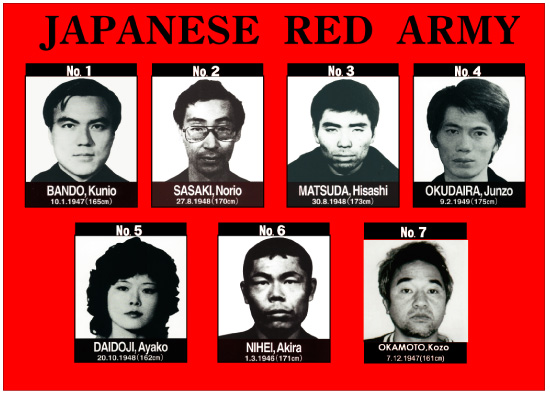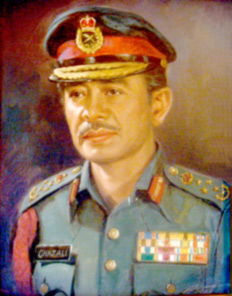In the previous article, we have
discussed about the threat that is posed by our neighbouring countries.
These traditional threats (called so as these are threats potentially
posed by one country to another) unfortunately are not politically
correct, thus seldom gain traction within our sociopolitical discussion sphere.
This article on the other
hand will touch on non-traditional threats. This is actually a
bit of misnomer as non-traditional threat is a common threat faced by
all nations. If handled incorrectly, non-traditional threats can easily
overwhelm a country and bring chaos to a country.
In the first 50 years of Malaysia's
existence, she was threatened by communist insurgency. Led by the
political bogeyman Ong Boon Hua or better known as Chin Peng, the word
communism became synonymous with treachery and evil to most Malaysians,
especially amongst rural Malaysians.
 |
| Japanese Red Army - the first foreign terrorist group to operate in Malaysia. |
On 5th August 1975, this changed when Japanese Red Army stormed the AIA Building located
in the middle of Kuala Lumpur. More than 50 individuals were taken
hostage. Thankfully, the incident was resolved without loss of lives.
Non-traditional threat can be largely
classified into two broad categories of threats; internal threat and external
threat.
Internal Threat
Internal threats can be further
classified into two categories; separatist movement and terrorist
group.
Separatist Movement
Separatist movement is a movement with
specific goals of gaining independence for a territory within a country.
Separatist movements are largely political movements. However, many
separatist movements also operate armed wing.
Examples of separatist movements are Sabah
Sarawak Keluar Malaysia (SSKM) and Sinn Fein.
As their struggles are political, the
best approach would be to allow them the freedom to share their views. In
fact, preventing them from voicing out their grievance is likely to further
inflame a segment of the society who would identify with their struggle.
Terrorist Groups
 |
| Malayan Communist Party |
The world has never been so dangerous
as before. Terrorist groups can be found in nearly every corner of the
world. The reason for formation of these groups varies from genuine and
legitimate reason to gain emancipation all the way to anarchist ideologists.
Some are formed for old times sake, ie al-Qaeda,
which means The Base, was originally for mujahidin veterans of Afghanistan War
against Russia. For the sake of discussion and categorisation, terrorist
groups under internal threat are home-grown terrorist groups. Local
branch of an international terrorist group should be considered as local
terrorist group as they are usually local affiliates and is not fully
controlled by the parent group.
Examples of such groups in Malaysian
context are Malayan Communist Party, Al
Mau'nah group, Kumpulan Militan Malaysia (KMM) and Tanzim al Qaeda.
External Threat
 |
| Velupillai Prabhakaran - his death heralded the end of LTTE. Or so we thought? |
External threats refer to threats posed
by individuals or entities beyond the normal border of a country. These
are usually terrorist groups which are founded overseas but operates in another
country. Example of external threats posed by terrorists groups are that
of Khatibah Nusantara, Abu
Sayyaf Group, and Liberation of Tamil Tigers of Eelam (LTTE -
once thought to have cease to exist after the death of Prabakharan during the
final days for Sri Lankan civil war in Jaffna, the group is believed to have since revived
itself with fresh membership).
Criminal Element
Criminal element comes into the picture
under the following circumstances:
- Large syndicated crime organisation may be able to threaten the
security of a country. Examples of criminal organisations that can
directly threaten the existence of a country are Los
Zetas and Medellin cartel. Financial strength from
drug cartelling gave these criminal organisation more than sufficient fund
to buy enough weapons to go head-to-head against the government of their
respective countries. Please note, while they do appear to have
similar characteristics with terrorist organisations, they have different
underlying reasons; terrorists with their ideology while drug
dealers their money.
- Conduit for terrorist and foreign intelligence services.
Weapons used by terrorists in the attack in Paris and Madrid bombing
were tracked to smuggling syndicate. While during the Cold War, both
sides were known to utilise contacts within smuggling syndicates to
smuggle their agents into and out of infiltration area.
- Syndicates can also be involved in assisting foreign forces in
invasion. During Second World War, bad relationship between
Mussolini's Fascist government with the Mafia of Sicily had led to the Mafia assisting Allied forces by
sabotaging Mussolini's forces and Nazi Germany's forces effort in
defending Sicily from Allied's invasion. (Another factor was that
many of the Sicilian Mafia had relatives in the United States that had
been drafted into US Army).
How does these Threats Affect Procurement?
Before we explore what are categories
of assets should be procured for non-traditional threats, we need to understand
that most if not all of these threats should be handled as police matters.
Only when the threats reach certain level that it would require military
intervention.
As we are specifically discussing on
procurement of assets for national defence, our focus would be on purchasing of
defence assets for the purpose of counter-insurgency warfare.
The continuous threats posed by
communism after Merdeka saw that Malaysian military being geared specifically
to counter-insurgency warfare, or in short, COIN warfare. The threats
posed by insurgency warfare resulted in defence spending being focused on
counter the threats from communists.
This in turn had pushed our military
procurement to purchase assets that is more suitable for counter-insurgency.
Little or less focus were made on purchasing assets that can be used for
conventional forces.
During the recent threats to Sabah, we
have seen our government reacting with the same manner. The last 20 years
have seen MAF moving from being a COIN-centric force to a conventional force
(one must admit our effort to build a conventional armed forces was wanting due
to lack of a proper guiding policy). The threat in turn saw MAF
refocusing on procuring assets that are suitable for COIN warfare. The
purchase of 6 MD530G helicopters
is a proof of the switch.
While some may see that the purchase as
a step back (ie viewing the purchase as an attempt to reconfigure MAF from a
conventional-centric force to be a COIN-centric force), the fact is you need a
COIN-capable force to fight a COIN warfare.
US Military Mistake in Vietnam
US military made the mistake in Vietnam
where they had used conventional warfare tactics against Viet Cong forces.
By focusing on numerical and technological advantages only, US military
soon found they were at disadvantage. The only US military units that
were effective against Viet Cong were US Marine and Green Beret (Nagl, 2002).
Ironically, the US military command were not happy with the units as they
do not operate within normal conventional military structure and had them
redeployed as conventional forces. This had further reduced their
effectiveness and played a role in the fall of South Vietnam.
COIN-Centric Vs COIN-Capable
As mentioned earlier, COIN-centric
focus means the military is being drawn along the line of non-conventional
warfare, with focus on section-level capabilities. The military focus on
being able to operate and fight the enemy using the same tactics used by the
enemy. COIN-centric forces do not have capability or have very limited
capability to operate a division-wide task as their operations at most are
company-sized movement. Combined arms capability is either non-existent
or very limited, as area of operations are too deep into the jungle to co-opt
armour element and artillery element. At most, close air support and
casevac (casualty evacuation) are available if needed.
Using this definition, Malaysian Army
of the past do not fit into this definition as Malaysian Army did operate at
divisional level (Op Gonzalez, the brainchild of then Lt Gen Ghazali Seth was at
divisional level).
Whereas a COIN-capable force is a
conventional military force with the ability and necessary assets to conduct
COIN operations. The military command structure understands and is able
to implement hearts and minds campaign in the area of operations and is
flexible enough to be able to accept non-conventional idea when facing an
insurgent force. Success is measured in terms of areas under control
instead of kills. A very good example of a COIN-capable force is British
Armed Forces and US Armed Forces during the last 5 years. Therefore,
Malaysian Government should endeavour for our Malaysian Armed Forces to be
reconfigured as a conventional armed forces with COIN-centric
capabilities.
What Assets are Suitable?
To face non-traditional threats, the
most critical addition to a conventional force is helicopter. Granted,
any modern conventional military already have helicopters in their inventory.
In the context of facing a
non-traditional enemy, the government should consider to purchase suitable
dedicated helicopters to be placed under the control of Royal Malaysian Police
Force air wing. The helicopters and their respective crews should be dedicated
quick-reaction force.
As for the threat posed by the Suluk
intruders in Eastern Sabah, a propeller fixed wing close air support aircraft
should be considered to complement rotary wing support. Propeller-type is
preferred as they travelled slower. Thus would be able to identify ground
situation better than a jet-type fixed wing aircraft. Plus, it is more
cost effective to use a propeller-type aircraft as compared to using jets.
However, it would prudent for me to
remind the government that we face not only non-traditional threats but also
traditional threats. Assets for conventional armed forces needs to be
procured to prevent ourselves from becoming a shadow force that would be easily
pushed aside by other countries.
In the next article, we will look into
logistical consideration. More often than not, logistics are usually
overlooked when either the government or military plans for new assets
procurement.
Other than logistics consideration,
Malaysian military assets purchase seems to have no regards on operational
requirements, purchasing assets in very small quantity.

No comments:
Post a Comment